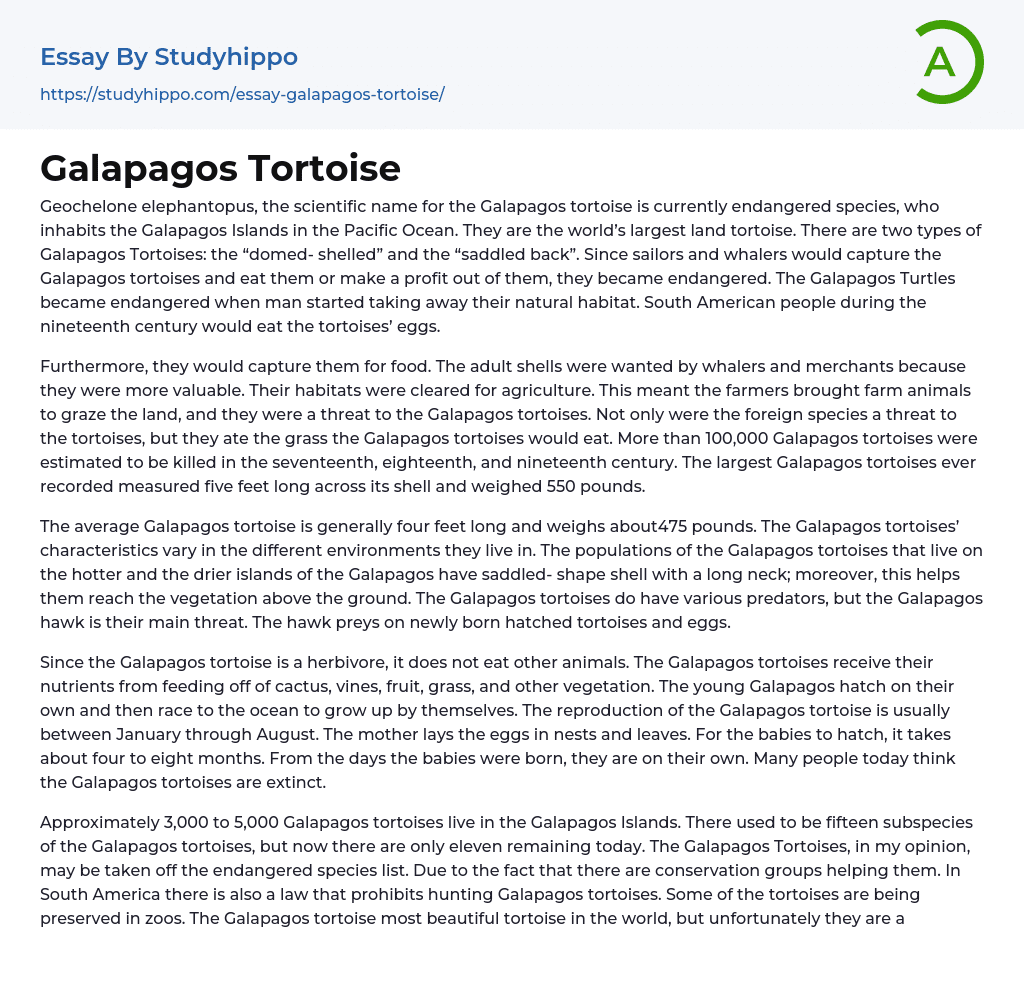Geochelone elephantopus, the scientific name for the Galapagos tortoise is currently endangered species, who inhabits the Galapagos Islands in the Pacific Ocean. They are the world’s largest land tortoise. There are two types of Galapagos Tortoises: the “domed- shelled” and the “saddled back”. Since sailors and whalers would capture the Galapagos tortoises and eat them or make a profit out of them, they became endangered. The Galapagos Turtles became endangered when man started taking away their natural habitat. South American people during the nineteenth century would eat the tortoises’ eggs.
Furthermore, they would capture them for food. The adult shells were wanted by whalers and merchants because they were more valuable. Their habitats were cleared for agriculture. This meant the farmers brought farm animals to graze the land, and they w
...ere a threat to the Galapagos tortoises. Not only were the foreign species a threat to the tortoises, but they ate the grass the Galapagos tortoises would eat. More than 100,000 Galapagos tortoises were estimated to be killed in the seventeenth, eighteenth, and nineteenth century. The largest Galapagos tortoises ever recorded measured five feet long across its shell and weighed 550 pounds.
The average Galapagos tortoise is generally four feet long and weighs about475 pounds. The Galapagos tortoises’ characteristics vary in the different environments they live in. The populations of the Galapagos tortoises that live on the hotter and the drier islands of the Galapagos have saddled- shape shell with a long neck; moreover, this helps them reach the vegetation above the ground. The Galapagos tortoises do have various predators, but the Galapagos hawk is their main threat. The hawk prey
on newly born hatched tortoises and eggs.
Since the Galapagos tortoise is a herbivore, it does not eat other animals. The Galapagos tortoises receive their nutrients from feeding off of cactus, vines, fruit, grass, and other vegetation. The young Galapagos hatch on their own and then race to the ocean to grow up by themselves. The reproduction of the Galapagos tortoise is usually between January through August. The mother lays the eggs in nests and leaves. For the babies to hatch, it takes about four to eight months. From the days the babies were born, they are on their own. Many people today think the Galapagos tortoises are extinct.
Approximately 3,000 to 5,000 Galapagos tortoises live in the Galapagos Islands. There used to be fifteen subspecies of the Galapagos tortoises, but now there are only eleven remaining today. The Galapagos Tortoises, in my opinion, may be taken off the endangered species list. Due to the fact that there are conservation groups helping them. In South America there is also a law that prohibits hunting Galapagos tortoises. Some of the tortoises are being preserved in zoos. The Galapagos tortoise most beautiful tortoise in the world, but unfortunately they are an endangered species.
- Rabbit essays
- Distribution essays
- Large Animals essays
- Mouse essays
- Poultry essays
- Animal Abuse essays
- Cats Vs Dogs essays
- Cattle essays
- Territory essays
- Owl essays
- Eggshell essays
- Feather essays
- Agriculture essays
- Albert einstein essays
- Animals essays
- Archaeology essays
- Bear essays
- Biology essays
- Birds essays
- Butterfly essays
- Cat essays
- Charles Darwin essays
- Chemistry essays
- Dinosaur essays
- Discovery essays
- Dolphin essays
- Elephant essays
- Eli Whitney essays
- Environmental Science essays
- Evolution essays
- Fish essays
- Genetics essays
- Horse essays
- Human Evolution essays
- Isaac Newton essays
- Journal essays
- Linguistics essays
- Lion essays
- Logic essays
- Mars essays
- Methodology essays
- Mineralogy essays
- Monkey essays
- Moon essays
- Mythology essays
- Noam Chomsky essays
- Physics essays
- Plate Tectonics essays
- Progress essays
- Reaction Rate essays




